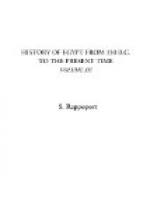The main theme of the story has occupied a great deal of attention. Its analogy to the Biblical narrative of Joseph and Potiphar’s wife comes at once into the reader’s mind. But there is just as close a similarity in the Greek tales, where the hero is killed or his life endangered for having scorned the guilty love of a woman, as in the stories of Hippolytus, Peleus, Bellerophon, and the son of Glaucus, not to mention the extraordinary adventure of Amgiad and Assad, sons of Prince Kamaralzaman, in the Thousand and One Nights.
The religions of Greece and Western Asia likewise contain myths that can be compared almost point for point with the tale of the two brothers. In Phrygia, for example, Atyo scorns the love of the goddess Cybele, as does Bata the love of Anpu’s wife. Like Bata, again, he mutilates himself, and is transformed into a pine instead of a persea tree. Are we, therefore, to seek for the common origin of all the myths and romance in the tragedy of Anpu and Bata that was current, we know not how long, before the days of King Seti?
Of one thing we may be sure: of this particular type the Egyptian tale is by far the oldest that we possess, and, if we may not look to the valley of the Nile as the original home of the popular tale, we may justly regard it as the locality where it was earliest naturalised and assumed a true literary form.
Analogies to the second part of the tale are even more numerous and curious. They are to be found everywhere, in France, Italy, Germany, Hungary, in Russia and all Slavonic countries, Roumania, Peloponnesia, in Asia Minor, Abyssinia, and even India.
Of late years an ever-increasing accumulation of the literature of every age of Egyptian history has either been brought to light or for the first time studied from a wider point of view than was formerly possible. In making a few typical selections from the mass of this new material, none perhaps are more worthy of note than some of the love-songs which have been translated into German from Egyptian in “Die Liebespoesie der Alten AEgypten,” by W. Max Muller. This is a very careful edition of the love-songs on the recto (or upper surface) of the Harris Papyrus 500, and of similar lyrics from Turin, Gizeh, and Paris. The introduction contains an account of Egyptian notions of love and marriage, gathered from hieroglyphic and demotic sources, and a chapter is devoted to the forms of Egyptian verse, its rhythm and accent. The interesting “Song of the Harper,” which is found on the same Harris Papyrus, is also fully edited and collated with the parallel texts from the Theban tombs, and compared with other writings dealing with death from the agnostic point of view. The following extracts are translated from the German:
LOVE-SICKNESS
I will lie down within doors For I am sick with wrongs. T hen my neighbours come in to visit me. With them cometh my sister, She will make fun of the physicians; She knoweth mine illness.
THE LUCKY DOORKEEPER




